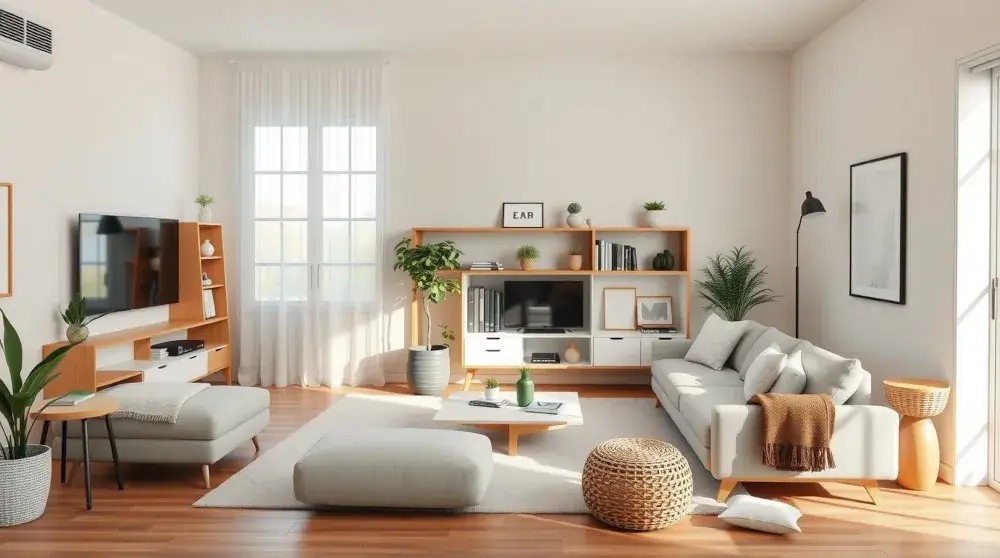
Last year, I remember standing in my kitchen staring at a counter piled with unopened mail, half-used grocery bags, and gadgets I never touched. It wasn’t just messy—it made me anxious. I kept thinking, “How can I focus when everything feels so out of control?”
Clutter creeps into our lives quietly. One day it’s a drawer, then a closet, and suddenly your entire home feels heavy. Research even shows that clutter increases cortisol (the stress hormone) and makes it harder to relax.
But here’s the good news: decluttering doesn’t have to feel overwhelming. With a room-by-room checklist, you can start small, make progress quickly, and actually enjoy the process. And unlike a one-time purge, this checklist is designed to help you build habits that keep clutter from coming back.
This guide is your pillar resource—you’ll find:
- Step-by-step checklists for every room.
- Mindset shifts that make decluttering easier.
- Seasonal routines so you never start from zero again.
- Links to deeper guides for sentimental, seasonal, mindful, and even digital clutter.
So grab a notebook, maybe a donation box, and let’s start transforming your home—one room at a time.
🛋️ Living Room Decluttering Checklist
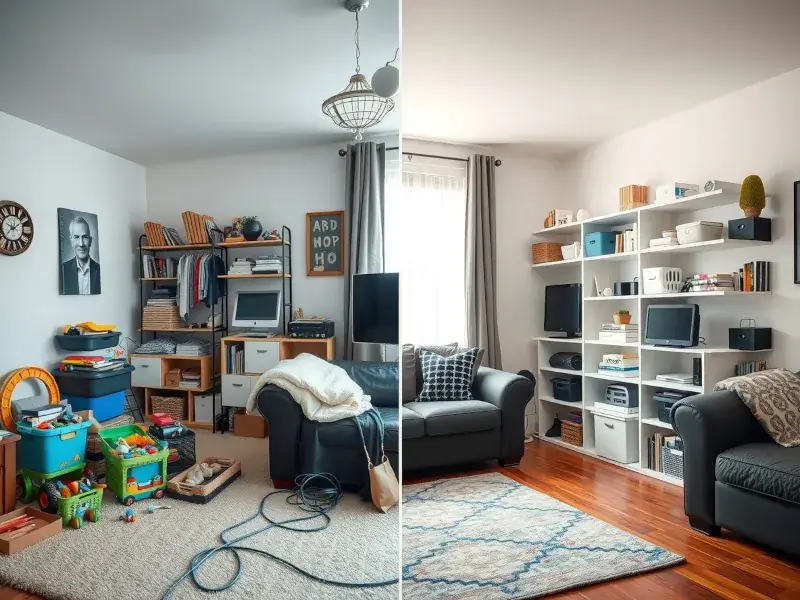
Your living room is where life happens—Netflix marathons, family chats, or guests dropping by. But if it’s filled with piles of magazines, cables, and too much décor, it feels more stressful than cozy.
Checklist:
- Coffee table: Choose one centerpiece—a plant, candle, or tray—and clear everything else.
- Books & décor: Keep what sparks joy, donate the rest. Don’t let shelves become dust collectors.
- Cables & remotes: Corral them in a basket. Bonus: no more “where’s the remote?” panic.
- Blankets & pillows: Limit throw pillows (3–5 is enough). Store blankets folded in a basket.
- Surfaces: Avoid clutter traps. A rule of thumb: 80% of a surface should stay clear.
👉 If you find yourself constantly buying décor that doesn’t fit, our Mindful Decluttering Guide will help you shop with intention.
When I cleared my coffee table for the first time, I felt oddly exposed—like the room was “empty.” But within a week, I realized it wasn’t emptiness, it was freedom.
👉 Recommended: collapsible fabric storage bins for throws or toys, and a cord management box for messy cables.
Make it guest-ready fast. See our full Decluttering Living Room guide for surface edits, toy containment, and cable control.
🛏️ Bedroom Decluttering Checklist
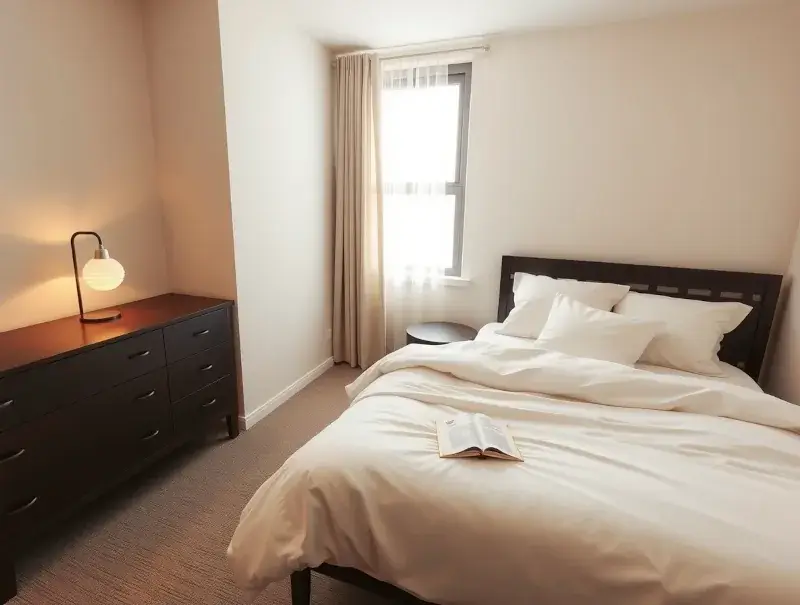
I used to think my bedroom was “fine.” Sure, the closet was full, drawers didn’t close properly, and my nightstand had become a mini junk drawer—but it wasn’t that bad. Then one night, after tripping over a pile of clothes for the third time, I realized my “relaxing space” felt more like a storage unit than a sanctuary.
Sound familiar? Bedrooms are often the first place clutter hides because it’s “out of sight” from guests. But the truth is, clutter in your bedroom quietly steals your rest and peace of mind.
Here’s how to reclaim it step by step:
- Start with the nightstand. Keep it simple: a lamp, a book, maybe a glass of water. Remove receipts, phone chargers, old medication, or that random lip balm you forgot about months ago. When you wake up and see a clean nightstand, your mind instantly feels calmer.
- Tackle the closet. Pull everything out—yes, everything. Try the hanger trick: hang clothes backward and only flip them after wearing. After 3–6 months, the untouched hangers tell you what you don’t actually wear. Donate those.
- Simplify your drawers. Use dividers for socks, underwear, and accessories. It’s amazing how much time you save when you’re not digging for a matching pair.
- Clear under the bed. If it’s just extra blankets or luggage, fine. But if it’s boxes of “I’ll deal with this later,” today is the day. Out of sight = still clutter.
- Be mindful of décor. Your bedroom doesn’t need ten throw pillows or five candles. Choose a few that make you smile and let go of the rest.
👉 If clothes feel too sentimental to donate, read our Decluttering Sentimental Items Guide.
When I finally decluttered my bedroom, it felt like breathing fresh air. For the first time in years, I walked in and thought: “This is a space I want to rest in.” That’s the power of a clutter-free bedroom.
Pro tip: Vacuum storage bags are lifesavers for seasonal clothing—slim, neat, and dust-free.
👉 Under-bed storage bags are perfect for small spaces and off-season clothes.
👉 Slim velvet hangers save closet space and keep clothes neat — a great minimalist decluttering trick.
Want the step-by-step version? Dive deeper with our full guide: Decluttering Bedroom Checklist — storage ideas, quick wins, and a nightly 5-minute reset.
🍳 Kitchen Decluttering Checklist
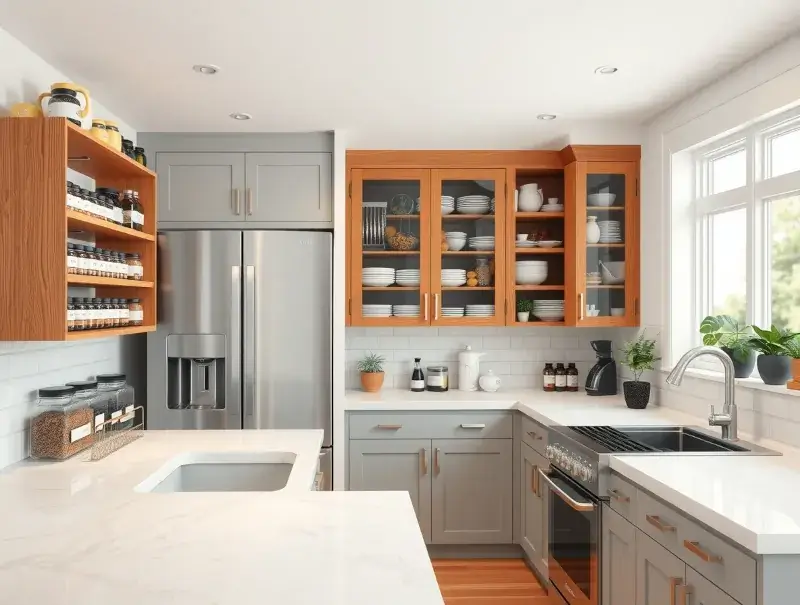
When friends come over, where do they end up? The kitchen. And yet, it’s one of the hardest rooms to keep organized. Between grocery hauls, endless mugs, and the “junk drawer” everyone seems to have, it’s easy for chaos to take over.
Here’s your action plan:
- Pantry reset: Pull everything out. Toss expired spices, half-used pasta bags, or stale snacks. Wipe shelves and reorganize by category (breakfast, baking, snacks).
- Counter cleanse: Challenge yourself to keep only two appliances visible—maybe the coffee maker and toaster. Everything else should have a “home.”
- Utensil drawer: Be honest—how many spatulas do you really need? Pick your favorites and donate duplicates.
- Fridge refresh: Toss forgotten condiments. Use clear bins for categories like “snacks,” “leftovers,” or “drinks.”
- Cabinets: Group items together. Put baking tools in one zone, everyday dishes in another.
💡 Hack: Keep a small basket labeled “Use Me First” for food close to expiration. It cuts waste and clears space.
👉 Want to stay on top of this every year? Our Seasonal Decluttering Guide shows exactly when to refresh your pantry and fridge.
Magnetic spice rack organizer keeps spices within reach and frees cabinet space.
Personal note: The first time I decluttered my kitchen, I found THREE unopened bottles of cinnamon. Now, with labeled bins and a spice rack, duplicates are history.
Need pantry and counter help? Get the room-specific walkthrough in Decluttering Kitchen Checklist — from pantry bins to clear countertop routines.
🛁 Bathroom Decluttering Checklist
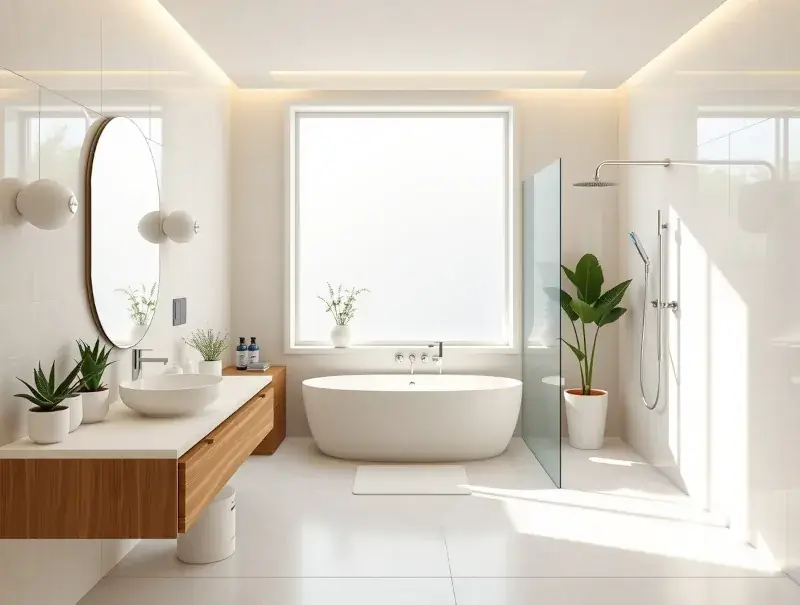
Bathrooms are small, so every bottle, brush, and tube matters. A cluttered bathroom feels chaotic instead of refreshing.
Checklist:
- Medicine cabinet: Toss expired meds, skincare, and sunscreen.
- Drawers: Use dividers for makeup, razors, or grooming tools.
- Shower/Tub: Limit products—one shampoo, one conditioner, one body wash. Use refillable dispensers to cut down plastic.
- Counter space: Keep daily essentials only—soap, toothbrush, maybe one skincare product.
- Backup supplies: Store extras (toilet paper, toothpaste) in bins under the sink.
👉 An acrylic drawer organizer keeps cosmetics in place, while a rust-resistant shower caddy organizes shampoos and soaps.
💡 Mindset shift: clutter in a bathroom often comes from duplicates—six half-used lotions, three bottles of the same hair spray. Finish one before opening another.
Short on space? Follow the complete Decluttering Bathroom guide for under-sink bins, drawer dividers, and a weekly mini-reset.
🧸 Kids’ Room / Play Area
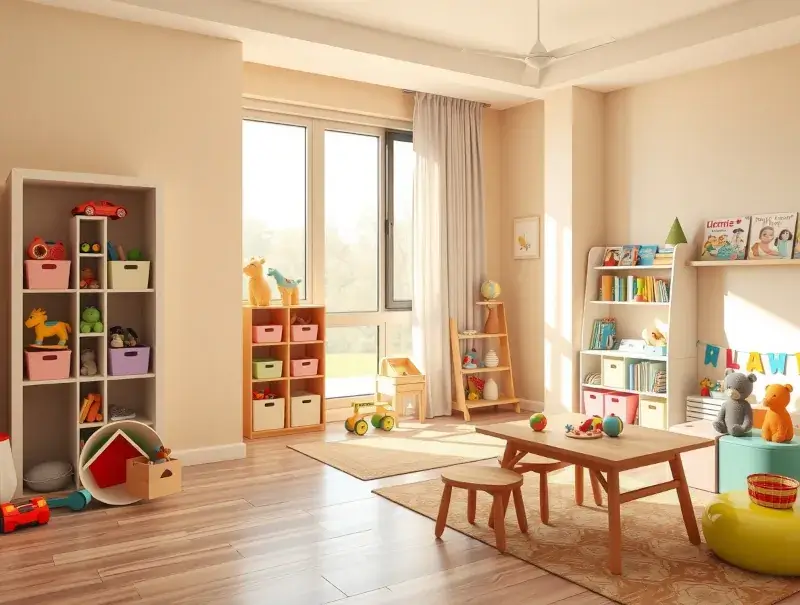
Toys have a sneaky way of multiplying. Without boundaries, they take over.
Checklist:
- Rotate toys monthly—kids get excited when old favorites return.
- Donate or sell outgrown toys.
- Sort toys into categories: blocks, dolls, puzzles.
- Label bins with words or pictures.
- Set a limit for stuffed animals (choose 10 favorites, donate the rest).
💡 Hack: Use cube organizers—easy for kids to use and simple for parents to maintain.
When I first rotated toys, I thought my kids would complain. Instead, they played longer with fewer options—proof that less really is more.
Too many toys? Try the game-plan in Decluttering Kids’ Room / Playroom — sort, rotate, and store with kid-friendly bins.
🏡Home Office Decluttering Checklist
A cluttered desk can quickly turn into a cluttered mind. Whether you work from home full-time or just use your office for bills and paperwork, decluttering your home office helps you focus, stay productive, and actually enjoy the space. Here’s how to simplify your work zone:
- Clear your desk surface. Remove everything and only put back your laptop, monitor, lamp, and maybe one personal item (like a plant or photo). Keep the rest in drawers or shelves.
- Sort papers into categories. Shred old bills and junk mail. File important documents into labeled folders or invest in a small filing cabinet.
- Declutter supplies. Do you really need five staplers and 20 pens? Keep only what you use daily and donate the rest.
- Cable control. Use clips, cord boxes, or zip ties to tame messy wires around your desk. A clean floor instantly makes the room calmer.
- Digital declutter. Clear your desktop, organize files into folders, and back up important data to cloud or external drive.
Pro Tip: End each workday with a 5-minute reset—put away papers, close your laptop, and return supplies to their spots. Tomorrow-you will thank today-you!
For a complete step-by-step system including product recommendations and space-saving hacks, see the full guide: Decluttering Home Office.
🚪 Closet & Wardrobe Decluttering Checklist
Does your closet feel packed but you still say “I have nothing to wear”? It’s time to reset your wardrobe. Decluttering your closet not only makes getting dressed easier but also helps you define your personal style. Use this checklist to simplify your space:
- Empty everything. Take all clothes out of the closet and drawers. Seeing the full pile helps you realize how much you actually own.
- Apply the keep/donate/toss rule. Keep what you wear often and love, donate items in good condition that no longer fit your style, and toss anything worn-out or damaged.
- Edit by category. Go through shirts, pants, dresses, shoes one by one. It’s easier to compare similar items and cut duplicates.
- Use matching slim hangers. They save space and make your closet look instantly more uniform and neat.
- Try the one-year rule. Haven’t worn it in the last 12 months? Time to let it go.
- Organize by season. Store out-of-season clothes in bins or on high shelves to free up daily space.
- Add storage helpers. Drawer dividers for accessories, hanging shelves for shoes, and clear boxes for handbags.
Quick win: File-folding t-shirts and jeans not only saves space but also makes everything visible at a glance.
Want a full breakdown of strategies, product ideas, and donation tips? Read our complete guide: Decluttering Closet & Wardrobe.
Seasonal Decluttering Checklist
Clutter has a sneaky way of building up with the seasons. Winter coats hang around in summer, holiday décor stays out too long, and kids’ items pile up as they grow. Seasonal decluttering keeps your home fresh year-round by helping you reset at the right times. Here’s how to approach it:
- Winter: Pack away holiday décor, rotate heavy blankets, and store bulky coats. Donate warm clothes you didn’t wear this season.
- Spring: Do a “spring clean” by decluttering cleaning supplies, refreshing linens, and switching heavy bedding for lighter options.
- Summer: Simplify outdoor gear, sort beach or pool items, and edit your summer wardrobe. Donate swimsuits or sandals that no longer fit.
- Fall: Rotate clothing again, declutter school supplies, and pare down kitchen gadgets before the holiday cooking rush.
- Décor rotation: Store out-of-season décor neatly in labeled bins. Keep only what you actually use to avoid overflowing storage.
- Quarterly audit: Every 3 months, walk through your home with a box for donations. You’ll catch clutter before it grows.
Pro Tip: Use clear storage bins with labels for seasonal items—so when the time comes, you can grab exactly what you need without digging through boxes.
For a complete plan on how to refresh your home every season (plus donation ideas and Amazon storage finds), check out the full guide: Seasonal Decluttering: How to Refresh Your Home Year-Round.
Decluttering by Room vs. Category
Some swear by room-by-room decluttering (like this checklist). Others love category decluttering (like KonMari).
- Room method: Easier for beginners. Quick wins.
- Category method: Prevents duplicates across rooms. More intense.
- Hybrid method: Start with rooms for momentum, then categories for depth.
No method is “best.” The best method is the one you’ll actually stick with.
Decluttering Mindset
Decluttering isn’t about throwing things away—it’s about being intentional.
- Start small: one drawer builds momentum.
- Progress > perfection: celebrate small wins.
- Avoid the organizing trap: don’t buy bins before decluttering.
- Practice one in, one out: every new item = one item leaves.
👉 More tips: Decluttering vs Organizing.
Common Mistakes
Avoid these pitfalls:
- Keeping “just in case” items.
- Decluttering when emotional.
- Buying bins before reducing.
- Forgetting digital clutter.
- Expecting to finish once and for all.
👉 Learn more: Digital Decluttering Tips.
Emotional Benefits
Decluttering reduces stress, increases focus, and even improves sleep. When your environment is calm, your brain follows.
Personally, the first night I slept in a clutter-free room, I didn’t just rest better—I felt lighter.
Decluttering for Small Spaces
Apartment dwellers face unique challenges. Solutions:
- Use vertical space (shelves, racks).
- Choose multi-purpose furniture (storage ottomans).
- Minimize duplicates.
- Be ruthless—small spaces = stricter curation.
Tools & Apps
Tech can help:
- Label makers.
- Apps: Todoist, Notion for checklists.
- Donation trackers for charitable giving.
- Printable decluttering checklists for quick wins.
FAQ: Decluttering Checklist
Q1: Should I declutter by room or by category?
It depends on your personality and lifestyle. Room-by-room decluttering is often easier for beginners because you see progress quickly and can actually “finish” a space. It also works well if you live with family members, since you can handle shared spaces together. Category decluttering (like the KonMari method) digs deeper and prevents duplicates—no more having kitchen scissors in three different drawers! A hybrid approach works best: start with one room for momentum, then revisit by category to refine.
Q2: How do I handle sentimental items without regret?
Sentimental clutter is the hardest. The key is to curate, not keep everything. For example, instead of keeping an entire box of old birthday cards, choose one or two that mean the most. If you struggle to let go, take photos of items before donating them—this way the memory stays without the physical bulk. Another tip: repurpose items, like turning a loved one’s old shirt into a pillow. For a deeper dive, check our Decluttering Sentimental Items Guide.
Q3: How do I stop clutter from coming back?
Decluttering once isn’t enough—you need habits that maintain it. Three powerful ones:
- One-in-one-out rule: Every time you buy something new, donate or toss one item.
- Five-minute resets: Spend 5 minutes before bed returning items to their homes.
- Mindful shopping: Pause before buying—do you really need it?
These habits ensure your home stays clutter-free. For lifestyle integration, check our Mindful Decluttering Guide.
Q4: What if my partner doesn’t want to declutter?
This is a common challenge. The key is to start with your own belongings. Lead by example rather than pressuring your partner. Show the benefits: cleaner spaces, easier mornings, less stress. Over time, most people warm up when they see positive results. For shared items, compromise—set boundaries like “this closet is yours, this one is mine.” Communication is critical: frame decluttering as improving the home, not controlling their choices.
Q5: How often should I declutter?
Think of decluttering like dental hygiene: small daily habits, plus occasional deep cleans. Do small resets weekly (like clearing surfaces). Seasonal check-ins (spring, summer, fall, holidays) help prevent buildup. Once a year, do a deep declutter across the home. By spreading it out, you avoid the stress of a single exhausting purge. Use our Seasonal Decluttering Guide as a reference.
Q6: Can kids actually learn to declutter?
Absolutely. Kids can learn responsibility if you make decluttering fun and simple. Use bins with picture labels (blocks, dolls, cars) so they can sort themselves. Give them choice—“Which 5 stuffed animals do you want to keep?”—so they feel ownership. Rotate toys to keep playtime exciting. And model the behavior: if they see you decluttering joyfully, they’ll imitate it. Over time, this builds lifelong habits.
Q7: Is digital clutter really as stressful as physical clutter?
Yes! Cluttered phones, overflowing inboxes, and messy desktops cause the same overwhelm as a messy closet. Digital clutter steals time and attention. Start small: unsubscribe from unwanted newsletters, delete duplicate photos, and set up folders for documents. Treat your phone home screen like your living room—clear, simple, functional. For a full plan, check our Digital Decluttering Tips.
Q8: What do I do when I have very little time to declutter?
Decluttering doesn’t require an entire weekend. Use the 15-minute rule: set a timer and tackle one area (a drawer, a shelf, a bin). Consistency beats intensity—daily micro-sessions add up. Another method: the “trash bag challenge”—grab one bag and fill it with donations in 10 minutes. These small wins build momentum, making bigger projects easier later.
Conclusion
Decluttering isn’t about less—it’s about making room for what matters. With this checklist, plus mindful habits and seasonal resets, you’ll create a calmer, lighter home. Start today with just one drawer. Tomorrow, your home (and your mind) will feel freer.
Disclaimer
This article may contain affiliate links. If you purchase through these links, I may earn a small commission at no extra cost to you. I only recommend products I personally find useful for maintaining an organized, clutter-free home.
